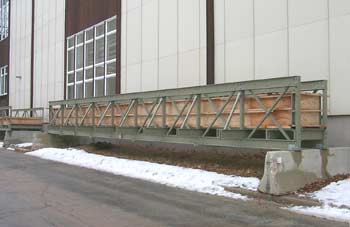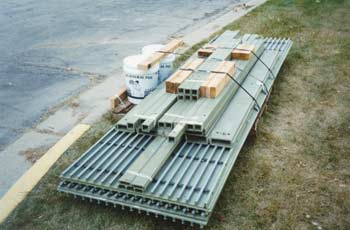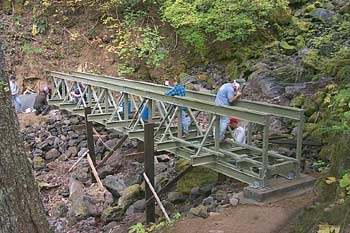Bridges Tested at the Forest Products Laboratory
In the fall of 1997, the FRP Trail Bridge Project Team selected two sites for fiberglass trail bridges. The first site was in the Gifford Pinchot National Forest northeast of Portland, OR, 1½ miles from the Lower Falls Creek Trailhead. A 44-foot-long by 3-foot-wide trail bridge (overall length is 45'6") was needed. This area has extreme snow loads (250 pounds per square foot). This bridge was funded by the FHWA and designed by their Eastern Federal Lands Bridge Design Group in consultation with E.T. Techtonics, Inc.
The second site was in the Wallowa-Whitman National Forest near Enterprise, OR, at the Peavine Creek Trail-head. A 22-foot-long by 6-foot-wide pack bridge was needed to fit abandoned road bridge abutments. The snow load at this site, 125 pounds per square foot, is more typical of Forest Service locations. This bridge was funded by the Forest Service and designed by E.T. Techtonics, Inc. The fiberglass channel and tube shapes for both bridges were manufactured by Strongwell and supplied by E.T. Techtonics, Inc.
Design Overview
The Falls Creek Trail Bridge was designed in accordance with AASHTO's Standard Specifications for Highway Bridges and the Guide Specifications for Design of Pedestrian Bridges.
Neither specification deals with FRP bridges, because specifications have not yet been approved—a major impediment for trail bridge designers. Additional guidance and design techniques were developed from sources in the FRP composite industry.
The Design Manual for EXTREN Fiberglass Structural Shapes (2002), developed by Strongwell, is a good source of information on the individual structural components. Because the FRP composite sections were patterned after shapes used in the steel industry, some guidance and design techniques were developed based on the Manual of Steel Construction (1989) from the American Institute of Steel Construction. In addition, E.T. Techtonics, Inc., helped interpret and modify existing information, provided test data on the strength of joints and connections, suggested improvements (such as filling the ends of hollow members), and reviewed the final design.
Each structural member of the bridge was designed with respect to standard strength parameters, including allowable tension, compression, bending, and shear stresses, as well as combined stresses due to axial forces and moments acting together. Primary loads included dead, snow, and wind loads. The design forces and moments were the maximum values generated by analysis.
Allowable design stresses were determined by dividing the ultimate strength of the FRP material (the strength at which it would break based on the manufacturer's data) by the following safety factors:
| Design stress | Safety factor |
|---|---|
| Tension and bending | 2.5 |
| Compression | 3.0 |
| Bearing | 4.0 |
To ensure that the bridge could support the anticipated snow loads, the stresses during the test at the Forest Products Laboratory were limited to no more than 30 percent of the ultimate bending and tensile strength. A full description of the design process, member stresses, and equations is in appendix H.
Materials
The structural sections making up the trusses for the two trail bridges were manufactured by Strongwell, a major manufacturer of fiberglass structural shapes, and came from the company's EXTREN line. EXTREN products contain glass fibers embedded in an isophthalic polyester resin (see glossary in appendix A). Each member also included a surface veil layer of polyester nonwoven fabric and resin for protection from ultraviolet exposure and corrosion. The decking also was a Strongwell product. It included a 6-millimeter (¼-inch) EXTREN sheet with a gritted surface on top of DURAGRID I-7000 25-millimeter (1-inch) grating. The composition of the grating is similar to that of the structural shapes except that the grating contains a vinyl ester resin binder. All of the FRP composite sections were manufactured using the pultrusion process.
Only two other materials were used in the superstructure of these bridges. The sections were connected with ASTM A307 galvanized bolts. The superstructures were attached to the foundations by ASTM A36 galvanized-steel anchor bolt clip angles.
Simulated Design Live Load Testing
Fiber-reinforced composite materials have different structural properties than conventional construction materials, such as steel, concrete, and timber. To verify the design of the 44-foot bridge, and to investigate the behavior of both the 22- and 44-foot bridges under actual use conditions, we tested both bridges under harsh environmental conditions while they were subjected to their full design loadings.
After the FHWA completed the design of the 44-foot bridge in the spring of 1998, materials for both bridges (figure 33) were shipped to the Forest Products Laboratory in Madison, WI, for full-scale testing. Weather conditions in Madison are severe, ranging from -30 to 100 degrees Fahrenheit. Humidity is relatively high, averaging about 65 percent.

Figure 33—Two FRP bridges—one 22 feet long (left)
and the other
44 feet long (right)—were tested at
the Forest Products Laboratory in
Madison, WI.
The materials (figure 34) for the 22-foot bridge weighed about 1,700 pounds. The materials for the 44-foot bridge weighed about 4,400 pounds. A five-person crew (two representatives from E.T. Techtonics, Inc., two engineers from the FHWA, and one engineer from the Forest Service) began constructing the 22-foot bridge on an FPL parking lot at about 2 in the afternoon. Three hours later, the bridge was completed. Construction of the 44-foot bridge began at about 8 the next morning and the construction was completed by early afternoon. A small forklift set both bridges onto 10-foot-long concrete traffic barriers, which served as bearing supports.

Figure 34—The materials for an FRP bridge after
delivery to the Forest
Products Laboratory.
The bridges were installed in a back parking lot and loaded to their full design loading (250 pounds per square foot for the 44-foot bridge and 125 pounds per square foot for the 22-foot bridge). Plywood boxes constructed on each bridge deck and filled with landscaping rock provided the load. Rock was 30 inches deep on the deck of the 44-foot bridge and 15 inches deep on the deck of the 22-foot bridge.
Deflection gauges (figure 35) were placed at the second panel point (4/9ths of the span) and at middle of the span of both trusses on the 44-foot bridge. Refer to appendix D for a drawing showing the location of the deflection and strain gauges. Because the bridge has nine 5-foot panels, the midspan deflection gauge is in the middle of the center panel. The 22-foot bridge has four 5-foot, 6-inch panels so the deflection gauges were placed at the center panel point of both trusses.

Figure 35—The typical setup of a deflection gauge used to test bridges.
Deflection measurements were taken immediately after loading and at several intervals during the first day. Readings were taken daily at first, then weekly and monthly after movement stabilized. Deflection measurement continued for 7 days after the test loads were removed. Neither of the bridges completely returned to the original, unloaded deflection.
Bridge deflections were monitored from October 1998 until August 1999. Refer to appendix D for data and graphs. The bridges performed well under load. Actual deflections closely matched the design deflections. When the bridges were disassembled, they had only minor problems.
One hole in a two-bolt connection between hollow members elongated and cracked on the 22-foot bridge (figure 36). The elongation was caused by slightly mismatched holes in the connecting members. Bolt holes need to be very closely aligned when members are fabricated. During testing, only one bolt was engaged initially. That hole elongated and began to fail. When the hole had elongated enough so that the second bolt became engaged, the connection held, preventing complete failure. The member was replaced with an end-filled (solid) member with precisely drilled holes before the bridge was placed at its final location.

Figure 36—This tube cracked when bolts were overtightened
on
one
of the
bridges being tested at the Forest Products Laboratory.
Analysis of Test Data
The deflection of the 44-foot bridge increased gradually at a decreasing rate for the first 30 days of loading, before stabilizing at a deflection of about 1.25 inches at midspan and 0.90 inch at the second panel point. This deflection was close to the calculated deflection of 1.30 inches at midspan. The deflection remained stable until about day 216 (May 3, 1999). At that point deflections began increasing at a slow, constant rate until day 280 (July 6, 1999) when the deflection increase accelerated. By day 289 (July 15, 1999), the deflection had again stabilized at about 1.49 inches.
The deflection of the 22-foot bridge followed much the same pattern. The wire used to measure deflection on side 2 was bumped while the bridge was being loaded, resulting in a slight difference in the deflections measured on each side of the bridge. The deflection graphs, although slightly displaced from one another are nearly identical for both trusses.
Fiberglass has a low modulus of elasticity (or stiffness) compared to other materials. When fiberglass is embedded in a polymer, the behavior of fiberglass is somewhat plastic—accounting for the gradual movement to the anticipated deflection over the first 30 days of the test.
As temperatures rise, fiberglass loses strength and stiffness. The increases in deflection correspond closely to increases in daytime temperatures in Madison. Information provided by Strongwell indicates that the ultimate stress can be reduced by as much as 30 percent when temperatures reach 125 degrees Fahrenheit and the modulus of elasticity can be reduced by 10 percent. Although reduced strength during hot weather concerned us during several weeks of the test period, real-life concerns would be minimal. Our design loading is snow load. The July and August pedestrian and stock loadings are brief and can be assumed to be no more than 85 pounds per square foot.
The bridges did not totally return to the unloaded condition because:
- The material is plastic and gradually reformed to the deflected
shape.
- Some slippage occurred in the bolt holes at the bolted connections.
Refer to appendix D for data and graphs.
Disassembly and Installation at Field Sites
On August 8 and 9, 1999, the bridges were disassembled (figure 37) and all the components were visually inspected for damage and wear. The bridges were shipped to their respective sites for permanent installation in September of 1999. The 44-foot bridge was installed in the Gifford Pinchot National Forest during October of 1999. The 22-foot bridge was installed in the Wallowa-Whitman National Forest during the summer of 2000.

Figure 37—Disassembling an FRP bridge after
testing at the Forest Products
Laboratory.
Falls Creek Trail Bridge
A county detainee crew hand-carried the 4,400 pounds of materials for the 44-foot Falls Creek Trail Bridge in late September (figure 38). Components for a comparable steel-truss bridge would have weighed about 10,000 pounds. That material would have been extremely difficult to pack to the bridge site, because the individual steel members would have weighed up to 500 pounds. The heaviest fiberglass members weighed 180 pounds. Even though these members were 45 feet long, they were flexible enough that they could be bent around tight corners of the trail.

Figure 38—Installing one of the tested FRP bridges
at Falls Creek in
the Gifford Pinchot National Forest.
The concrete abutments were cast during the first week of October 1999. An eight-person crew began installing the bridge the following week. Installation was completed shortly after noon of the second day. The bridge spans a very steep, sharply incised, intermittent channel about ¼ mile from a very popular scenic falls (figure 39). The Forest Service estimates peak use of this trail to be as high as 300 persons per day.

Figure 39—The Falls Creek
Trail
Bridge
provides
access to this waterfall.
Peavine Creek Trail Bridge
The 22-foot-long bridge was installed on the former site of a road bridge. The bridge was designed to be placed directly on the existing abutments. The site was accessible by a truck that delivered the materials and a small backhoe.The bridge was built on the approach roadway and lifted in one piece onto the abutments.
The bridge was constructed by the Wallowa-Whitman National Forest road crew and set in place in 1 day. Because the road crew was not familiar with FRP materials, they overtorqued the bolts, cracking several of the hollow tubes. These cracks, which have been monitored since installation, have closed slightly because of bearing compression of the FRP materials.
Reinspection
The bridges were reinspected during the fall of 2004. The cracks at the connections had not changed significantly and the members had a chalky appearance because the surface veil had developed fiber bloom. The Falls Creek Bridge had developed cracks at top post and at floor beam tie-down connections. Additional information is in the Case Studies and Failures section.

